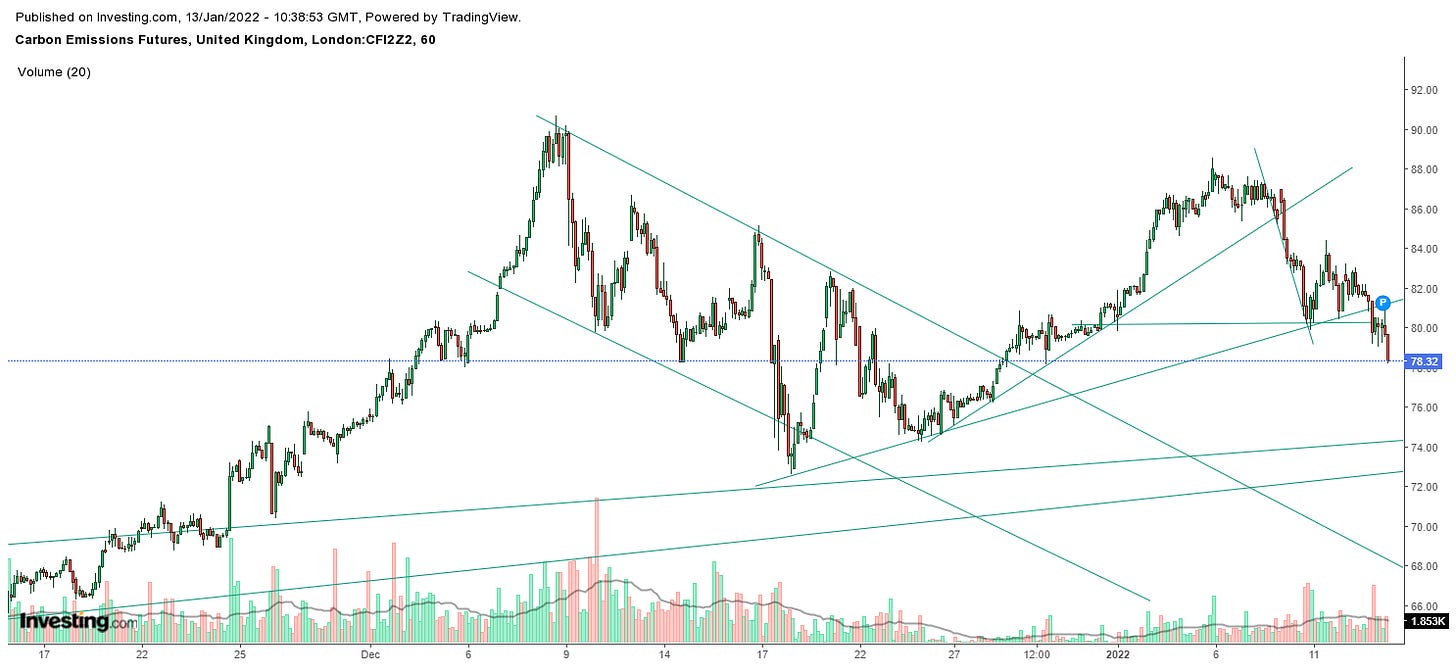Back to the 70's
The Dec-2022 EU carbon futures contract is now back below the key €80 per tonne level. Carbon is back to where it was two weeks ago. On the face of it that doesn’t sound like much to worry about. But delve deeper and the carbon market might be set for an extended stay in the 70’s, or even lower.
The chart below is the hourly EU futures chart from mid-November to mid-January. The key bullish news occurred on 25th November when the German government announced that they proposed introducing a national carbon floor price of €60 per tonne (and campaign for an EU wide floor) should EU carbon prices fall below that level (German coalition proposals de-risk the path to higher carbon prices).
The expiry of options provided the final leg of support to the carbon price into mid-December. Earlier in 2021 participants (both financial and compliance) bought call options that would pay out if the EU futures price of carbon reach certain thresholds. Big call option open interest incentivise market participants to purchase the underlying futures contract (either speculatively or to hedge) so that the calls expire in the money (The witching hour approaches: The increasing role that options play in the EU carbon market).
The expiry of those options, renewed political pressure from some EU member states on the role of speculation in the carbon market and whether carbon prices are responsible for high energy prices for households and business, and news of an influx of LNG into Europe sent the market back down to the low 70’s (Carbon crash: WTF happened?).
Carbon prices rebounded over the second half of December to over €88 per tonne. This time of year, ending on 10th January is typically a period of low supply in the EU ETS as weekly auctions are paused. Meanwhile, all the talk before 2022 was that nuclear shutdowns in Germany would increase demand for emission allowances, supporting the carbon market. Alas, since the beginning of 2022 the carbon market has gone into reverse as tighter margin requirements (The wrecking ball: Margin calls, illiquidity and the race for collateral), a shift in the one way ticket narrative ('Greenflation' fears are a twin threat to the EUs monetary and climate credibility), and weak emission allowance auctions have come together to take the heat out of the carbon market.
Other factors on the horizon could also be weighing on sentiment including the final report (due early in 2022) from the European Securities and Markets Authority (ESMA) on the functioning of the EU carbon market. Specifically, ESMA was tasked with examining carbon trading behaviour and whether the market needed to be reformed in some way to help respond to the energy crisis. The preliminary report was published in mid-November and concluded that EU ETS participant activity has not “significantly changed since 2018 and is broadly in line with the expected functioning of the market, where non-financial entities buy EUA futures to hedge their carbon price exposure, while financial counterparties act as intermediaries to facilitate trading and provide liquidity to the market" (The changing fortunes of the EU carbon market).
Where do we go from here? As I outlined above, option market activity was one of the major driving forces for the EU carbon market late in 2021. Although activity in 2022 has been steadily increasing, open interest is still lagging behind compared to year earlier levels. The largest options strike activity was at the €80 level and showed an extremely bullish put-call ratio. A decline below this level is significant, and could prompt a further unwind of positions.
Next downside targets are the long term resistance line (beginning in July 2020), the first of two long term support lines (beginning in November 2020). This could see prices fall to the low €70 per tonne mark in coming weeks. If those fail then carbon prices could fall to €65 per tonne (the second long term support line), or even lower to €60 per tonne. This is where political will in carbon markets will really be tested.






